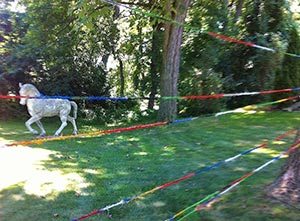
Paul Kolker: String Theory…and Painterly Up Close!, op. 7, 2015
ultra hd 4,356 dpi c-print on styrene (unique) — 20×20 inches
In 1961, as a doctor serving in the US Air Force, Kolker was already an accomplished medical illustrator, air brusher and a photorealistic painter at age 26. Influenced by the then abstract expressionists and having learned to conglomerate paraffin, beeswax with oil based paints, he overlaid his photographic paintings with dripped strings of encaustic paint to abstract the image. This exhibition links those primordial drip and string paintings with the current UltraHD dot pixellated works.

To further clarify how seeing things up close comports with that coastline analogy of fractal geometry, microscopic cellular structures which may appear to us as abstractions up close, tend to replicate into the anatomical morphology of the view from afar; like leaves becoming trees… which form the forest. The only difference is the zoom apparatus and the perceptual understanding of the viewers who have been educated like Kolker in the disciplines of both gross and microscopic anatomy; i.e. learning to see from afar and up close. Please note, String Theory… and Painterly Up Close! op.7, 2015, depicted above in its fibrillar glory, is an ultra high definition 4,356 dpi metallic C-print of the digitally enhanced close-up cropping achieved by using a macro lens to photograph the magnified details of the the original acrylic on canvas painting, String Theory… Up Close!, 2015.
Paul Kolker (b. 1935) is a New York based artist with doctorate degrees in medicine and law. He is Emeritus Chief of Cardiothoracic Surgery at North Shore/ LIJ Glen Cove Hospital, having practiced cardiothoracic surgery on Long Island from 1969 to 2013. In October 2001 Kolker moved his Long Island studio to his current address in the Chelsea art district so that he could produce his works and curate his exhibitions as an experiment in perception. His studio and gallery have together become his laboratory in which the viewer is the measuring instrument for Kolker’s art as a perceptual experiment. String Theory…Up Close! is Kolker’s fiftieth solo exhibition.
In Paul Kolker: String Theory… Up Close!, thirty-six paintings, prints and sculptures are on view at the PAUL KOLKER collection from September 17 through December 1, 2015 at 511 West 25th Street in Chelsea adjacent to the High Line between Tenth and Eleventh Avenues. For further information please email info@paulkolker.com.
